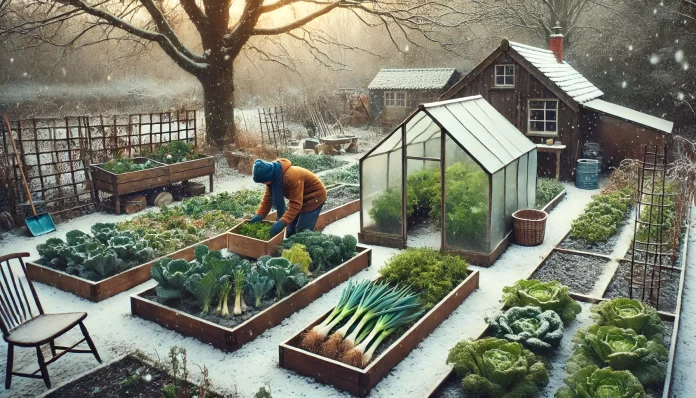Winter gardening offers the opportunity to enjoy fresh, homegrown produce even in the colder months. By selecting the right vegetables, preparing your garden, and using simple techniques to protect plants from frost, you can extend your harvest well into the winter season. Whether you’re a seasoned gardener or just starting out, this guide will help you grow a productive winter vegetable garden.
Why Grow Winter Vegetables?
Winter vegetables thrive in cooler temperatures and often taste better after a frost, as the cold converts their starches into sugars. Growing your own food during winter reduces grocery costs, ensures freshness, and makes good use of your garden year-round.
Top Vegetables to Grow in Winter
- Kale
- Hardy and highly nutritious, kale is one of the easiest winter crops.
- Varieties like ‘Nero di Toscana’ and ‘Winterbor’ are ideal for frosty climates.
- Spinach
- Cold-tolerant and fast-growing, spinach provides a steady supply of fresh greens.
- Sow in autumn for a continuous harvest into early spring.
- Brussels Sprouts
- These classic winter vegetables improve in flavor after frost.
- Plant early in summer for a late autumn to winter harvest.
- Winter Lettuce
- Varieties like ‘Winter Density’ and ‘Arctic King’ thrive in low light and cold.
- Grow under cloches or in cold frames for protection.
- Parsnips
- Known for their sweet, earthy flavor, parsnips benefit from cold weather.
- Sow in spring and leave them in the ground to harvest throughout winter.
- Leeks
- Slow-growing but extremely hardy, leeks are a reliable winter crop.
- ‘Musselburgh’ and ‘Bandit’ are excellent varieties.
- Carrots
- Late-sown carrots, such as ‘Autumn King’, can be stored in the ground under mulch.
- Garlic
- Plant cloves in autumn for a summer harvest. Garlic needs the cold to develop properly.
Preparing Your Garden for Winter Vegetables
- Choose the Right Site
- Select a sunny, sheltered area with well-draining soil.
- Improve Soil Quality
- Add compost or well-rotted manure in autumn to enrich the soil.
- Plan for Protection
- Use cloches, fleece, or cold frames to shield crops from frost and harsh winds.
- Succession Planting
- Plan for staggered sowings to ensure a steady supply of vegetables throughout winter.
Caring for Winter Vegetables
- Watering: While winter crops need less water, avoid letting the soil dry out completely.
- Weeding: Keep the garden weed-free to reduce competition for nutrients.
- Mulching: Apply a layer of straw or leaf mold around plants to insulate the soil and retain moisture.
- Pest Management: Watch for slugs, which can thrive in damp conditions. Use organic deterrents like beer traps or crushed eggshells.
Using Structures for Winter Gardening
- Cold Frames: Protect tender crops and extend the growing season.
- Polytunnels: Offer more space for larger plants and improve temperature control.
- Greenhouses: Ideal for growing winter vegetables and propagating seedlings.
Harvesting Winter Vegetables
- Harvest vegetables like kale, spinach, and lettuce leaf by leaf for a continuous supply.
- Root crops such as carrots and parsnips can be left in the ground until needed.
- Brussels sprouts are best picked from the bottom up as they mature.
Winter Gardening for Beginners: Tips for Success
- Start Small: Begin with a few hardy crops like kale and spinach.
- Invest in Protection: Use cloches, fleece, or mulch to prevent frost damage.
- Observe the Weather: Pay attention to frost forecasts and cover plants as needed.
- Learn from Experience: Experiment with different crops and techniques to discover what works best in your garden.
Conclusion
Growing winter vegetables is a rewarding way to keep your garden productive year-round. With the right crops, proper preparation, and a little care, you’ll enjoy fresh, flavorful produce straight from your garden—even in the depths of winter.
Would you like help with illustrations, recipes for winter vegetables, or tips on cold storage?




